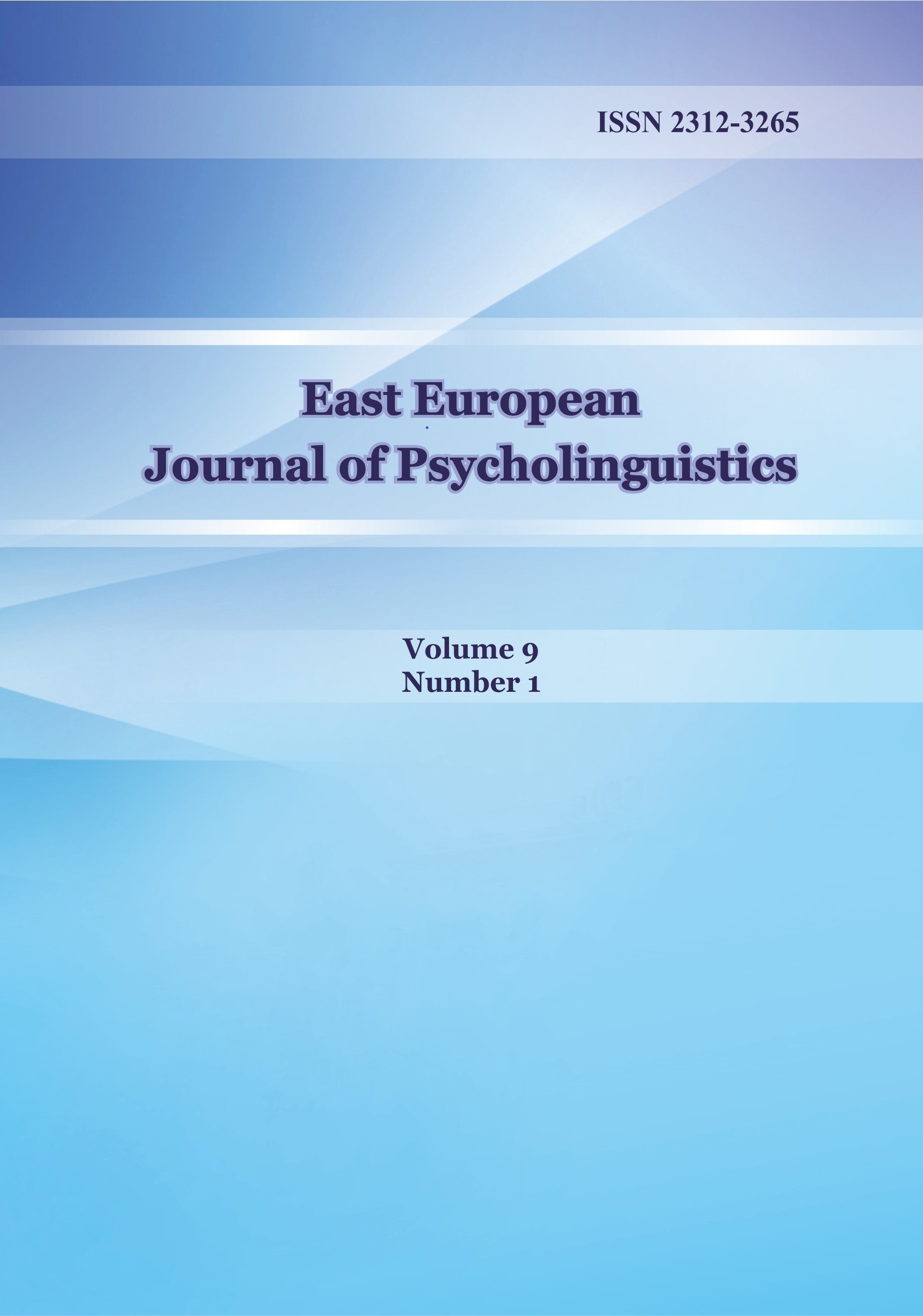Психолінгвістичні та лінгвокультурні аспекти асоціативних реакцій на німецькі слова-стимули Humor та Lachen
DOI:
https://doi.org/10.29038/eejpl.2022.9.1.zubКлючові слова:
асоціативний експеримент, семантичний гештальт, німецька мова, лінгвокультурологічний аналіз, психолінгвістикаАнотація
Мета статті – виявлення специфіки німецьких слів-стимулів Humor та Lachen на засадах лінгвокультурологічного та психолінгвістичного аналізів з метою визначення особливостей когнітивної діяльності особистості у сміховому просторі цільової лінгвокультури. У дослідженні застосовано метод вільного асоціативного експерименту, в якому досліджено особливості сприйняття слів-стимулів Humor та Lachen у сучасному соціумі, з’ясовано типові та індивідуальні реакції. В експерименті взяло участь 60 студентів бакалаврату віком 20-22 років освітньо-професійної програми «Мова та література (німецька). Переклад» Волинського національного університету імені Лесі Українки (Україна). На основі кількісного аналізу слів-асоціацій та методу семантичного гештальта виокремлено продуктивні семантичні зони та реакції щодо кожного зі слів-стимулів, які представляють специфіку ідентифікації лінгвокультури. Продуктивними реакціями виокремлено іменникові, прикметникові та дієслівні. Аналіз асоціативних полів дав змогу змоделювати взаємодію психолінгвістичних та лінгвокультурологічних засад для виникнення реакцій на слова-стимули Lachen та Humor. До продуктивних профілів реакцій належать комунікативний, прагматичний та когнітивний. Ядерні зони в кожному асоціативному полі виявили тенденцію до однотипності вираження позитивних емоцій. Респонденти репрезентували широкий обсяг семантичного потенціалу слів-стимулів та частотності обернених реакцій. Виразний спектр продуктивності індивідуальних асоціатів запропонований респондентами має інтерпретаційний характер та є результатом ментальної та вербальної когніції сміхової культури.
Завантажити
Посилання
Attardo, S. (2003). Introduction: the pragmatics of humor. Journal of Pragmatics, 35(9), 1287–1294. https://doi.org/10.1016/S0378-2166(02)00178-9
Bakhtin, M. Rabelais and his World. Cambridge, Mass: MIT Press.
Cann, A., Matson, C. (2014). Sense of humor and social desirability: Understanding how humor styles are perceived. Personality and Individual Differences, 66, 176–180. https://psycnet.apa.org/doi/10.1016/j.paid.2014.03.029
Charaudeau, P. (2006). Des catégories pour l’humour? Questions de Communication, 10, 19–41. http://dx.doi.org/10.4000/questionsdecommunication.7688
Edgar, A., & Sedgwick, P., (eds). (2007). Cultural Theory: The Key Concepts. London: Routledge.
Garnham, A. (1985). Psycholinguistics: Central Topics. London & New York: Methuen.
Ginzburg, J., & Mazzocconi, C. & Tian, Y. (2020). Laughter as language. Glossa: A Journal of General Linguistics 5(1), 104. 1–51. https://doi.org/10.5334/gjgl.1152
Goroshko, Ye. (2001). Integrativnaja model' svobodnogo associativnogo eksperimenta [An Integrative Model of Free Association Test]. Kharkiv: RA – Karavella.
Hui, L. (2011). An Investigation into the L2 Mental Lexicon of Chinese English Learners by Means of Word Association. Chinese Journal of Applied Linguistics, 34(1). https://doi.org/10.1515/cjal.2011.005
Lopez, B. G., Vaid, J. (2017) Psycholinguistic approaches to humor. In S. Attardo (Ed.), The Routledge Handbook of Language and Humor (pp. 267–281). New York: Routledge
McGraw, P., C. Warren (2014). ‘Benign Violation Theory’. In Attardo, S. (Ed.), Encyclopedia of Humor Studies. (pp. 75–77). Los Angeles; London; New Delhi: Sage.
Namei, S. (2004). Bilingual lexical development: A Persian-Swedish word association study. International Journal of Applied Linguistics, 14(3), 363–388. https://doi.org/10.1111/j.1473-4192.2004.00070.x
O'Donnel-Trujillo, N., Adams K. (1983). Heheh in Conversation: Some Coordinating Accomplishments of Laughter. Western Journal of Speech Communication, 47(2), 175–191. https://doi.org/10.1080/10570318309374114
Piemonte, N. M. (2015). ‘Last laughs: Gallows humor and medical education’. Journal of Medical Humanities,36(4), 375–390. https://doi.org/10.1007/s10912-015-9338-4
Podilchak, W. (1992). Fun, funny, fun-of humor and laughter. Humor, 5, 375–396. https://psycnet.apa.org/doi/10.1515/humr.1992.5.4.375
Riesch, H. (2015). Why did the proton cross the road? Humour and science communication. Public Understanding of Science, 24 (7), 768–775. https://doi.org/10.1177/0963662514546299
Savage, B. M., Lujan H. L., Thipparthi R. R. & DiCarlo, S. E. (2017). Humor, laughter, learning, and health! A brief review. Advances in Physiology Education, 41(3), 341–347. https://doi.org/10.1152/advan.00030.2017.
Séguin, M. (2015). Exploration of the relationship between word-association and learners’ lexical development with a focus on American L1 and Croatian L2 speakers. Explorations in English Language and Linguistics, 3(2), 80–101. https://doi.org/10.1515/exell-2017-0003
Shono, Y., Ames, S., Stacy, A. (2016). Evaluation of internal validity using modern test theory: Application to word association. Psychological Assessment, 28(2), 194–204. https://doi.org/10.1037/pas0000175
Stillings, N. A., Chase, Chr. H., Weisler, S. E., Feinstein, M. H., Garfield, J . L., Rissland, E. L., & Weisler, S. W. (1995). Cognitive Science: An Introduction. Cambridge, MA: MIT Press.
Takovski, A. (2021) Lubricating culture awareness and critical thinking through humour. The European Journal of Humour Research 9 (4), 1–19. http://dx.doi.org/10.7592/EJHR2021.9.4
Terekhova, D. (2014). Analiz assotsiatyvnykh poliv sliv-stymuliv МИР / МИР / МІР u skhidnoslovyanskikh movakh [The analysis of associative fields of stimulus words МИР / МИР / МІР (PEACE) in East-Slavonic languages]. East European Journal of Psycholinguistics, 1(1), 194–201. Retrieved from https://eejpl.vnu.edu.ua/index.php/eejpl/article/view/228
Sources
Duden, Deutsches Universal Wörterbuch A–Z. (1989). 2., völlig neu bearb. u. erw. Mannheim: Aufl. Bibliographisches Institut & F. A. Brockhaus AG.
Завантаження
Опубліковано
Номер
Розділ
Ліцензія
Авторське право (c) 2022 Oksana Zubach

Ця робота ліцензується відповідно до ліцензії Creative Commons Attribution 4.0 International License.












 Creative Commons «Attribution» 4.0
Creative Commons «Attribution» 4.0